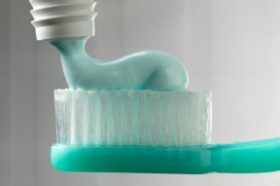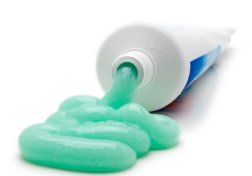Looks Like It Is Pooping Blue Toothpaste Tube Squeezing Out Paste
There's nothing scientific about the way I shop for toothpaste. One brand happens to have the same name as the street on which I grew up. So, that's the kind I buy.
Quite a bit of science, however, goes into making toothpaste. Every year, toothpaste companies spend millions of dollars looking for ways to make products that taste better, make your teeth cleaner, and keep you coming back for more.
 |
| Toothpaste is a "soft solid" that comes out of a tube easily but keeps its shape on a toothbrush—until you use it. |
| iStockphoto.com |
"Toothpastes are always evolving, always improving," says David Weitz, a physicist at Harvard University in Cambridge, Mass.
In recent years, the toothpaste aisle has exploded with choices. You can get pastes and gels that claim to whiten teeth, freshen breath, fight gum disease, control sticky buildup, and more. There are gentle products designed for sensitive teeth. Other products use only all-natural ingredients. New choices keep popping up all the time.
Squishy physics
Before any new type of toothpaste hits store shelves, scientists put it through a battery of tests. Companies need to be able to guarantee that their products do what they're supposed to. They also want to make sure that their toothpastes survive such factors as temperature changes during manufacture, transportation, storage, and, finally, brushing.
Meeting such criteria is harder than you might think. Each toothpaste is a finely blended mixture of liquids and small, sandy particles. Called abrasives, these particles scrub the grime off your teeth and make them white.
Pastes are technically solids, but they're a little more complicated than that. When you squeeze a tube of toothpaste, for example, the parts of the paste next to the tube's wall liquefy, allowing the solid center to flow out.
Perhaps most amazing, the particles in a paste are heavier than the other ingredients are, but somehow, they don't sink to the bottom. That's because molecules within the mixture form a network that holds everything in place.
"A paste is a very interesting solid from many points of view," Weitz says. "It's a network that supports itself. We're interested in understanding how it does that."
Tweaking formulas
The question of toothpaste's structure is especially important because companies are always tweaking the formulas of their products. And with every new ingredient added, there's a risk that the structure might be disturbed and that paste might fall apart. This would be disastrous.
 |
| Toothpaste is a finely blended mixture of liquids and small, sandy particles. |
| iStockphoto.com |
"If you bought a tube of toothpaste, and you found fluid on the top and sand on the bottom," Weitz says, "you wouldn't buy that toothpaste again."
In the interest of keeping toothpastes in one piece, scientists use sensitive microscopes and other instruments to measure the strength of bonds between particles. This information indicates how long the ingredients will stay mixed.
For the most part, researchers have found, toothpastes are very stable. It takes a long time for them to separate into layers.
There's an easy way to destabilize toothpaste, however, and it's something you do every day. After a few vigorous brushes, toothpaste turns into a liquid that you can swish around and spit out.
"One of the big developments in the field has been the recognition that there's a tremendous similarity between putting a force on a paste and waiting a long time," Weitz says. Both actions, in other words, tend to destabilize a paste.
One major research goal is to make pastes that last even longer.
"What we're in the process of doing is learning to understand and control the nature of structures that make particles form into a network," Weitz says. "We're giving companies enormous insights into how to go about improving their products."
Many choices
But the more choices a buyer has, the easier it is to lose track of what toothpaste is really for. Its main purpose is to prevent cavities—holes in the outer layer (enamel) of your teeth that can lead to pain, infection, and worse.
 |
| Brushing your teeth helps prevent cavities. |
| iStockphoto.com |
Cavities come from a film of bacteria called plaque. These bacteria secrete acids that eat away your teeth. By brushing and flossing, you prevent plaque from accumulating. Abrasives help rub away plaque. Some toothpastes also have extra bacteria-killing ingredients.
Other toothpastes focus on fighting tartar, a crusty buildup of calcium on the teeth. And some pastes have compounds that kill the bacteria that produce bad breath.
A new wave of toothpastes contains ingredients such as green tea, blue-green algae, grapefruit extracts, cranberries, and herbs. Recent studies suggest that these natural substances help fight cavities and gum disease.
"It's such a competitive marketplace out there," says Clifford Whall, director of the American Dental Acceptance Program at the American Dental Association. "So many new products are being introduced."
Fluoride focus
The choices can be overwhelming. But it doesn't matter much which brand you pick, as long as you choose one with fluoride, says Richard Wynn. He's at the University of Maryland's dental school in Baltimore.
Fluoride binds with enamel on your teeth and helps prevent cavities.
"I don't care what else is in it," Wynn says. "Just make sure it has fluoride."
After that, find a toothpaste that tastes good, feels good on your teeth, and fits your budget. Then, brush twice and floss once every day. Your smile will shine for many years to come.
Going Deeper:
Additional Information
Questions about the Article
Word Find: Toothpaste
Source: https://www.sciencenewsforstudents.org/article/putting-squeeze-toothpaste

0 Response to "Looks Like It Is Pooping Blue Toothpaste Tube Squeezing Out Paste"
Post a Comment